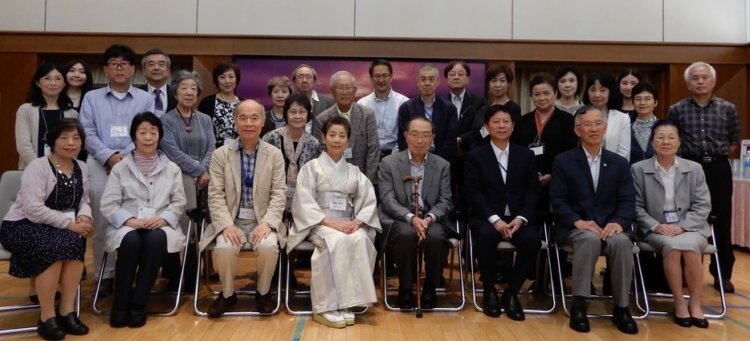MUA Visit to the Embassy of the People’s Republic of China in Tokyo
Date: Tuesday, July 16, 2019
Place: Moto
Moto-Azabu, Minato City
A group of 26 participants, headed by President Nagano of MUA and including its members and their families, visited the Chinese Embassy located in Moto-Azabu. At first, Ms. WANG Xiaoying, Political Section Attache, kindly introduced to us Mr. NI Jlan, Political Section Minister Councilor, and Mr.SHAO Hongwei, Political Section First Secretary. In response, Mr. Kobayashi, MUA Standing Director, introduced MUA President Nagan o to the Chinese hosts. We had the pleasure of receiving the following welcome speech an d presentation, respectively, from Minister Councilor NI and the First Secretary SHAO, concerning China Welcome speech by Minister Councilor NI Mass media has reported that the bilateral relations between China and Japan already recovered to the normal level, owing to the repeated meetings held between Prime Minister Abe and Chairman Si Jinping at the G20 Osaka Summit and other events. However, in order to build a nation-to-nation friendship, it is very important to promote grassroots, citizen-to-citizen interactions. I think we should let you know what occupies Chinese people’s minds so that a favorable neighbor country relationship can be established. Based on our two countries’ interaction, which has lasted for over 2,000 years, we should promote face-to-face dialog. From this viewpoint, I welcome whole-heartedly this meeting, which will strengthen our friendship with the Minato UNESCO Association, as a foothold of the state-level bilateral relations.
Viewing of the movie “Spring Festival Festival”
We enjoy ed watching an approx. 30-minuteminute-long movie on a large theater screen. It highlighted a variety of traditional ways how Chinese people celebrate the New Year in different regions.
Presentation by First Secretary
SHAO A very informative speech, accompanied by slide show, was given concerning the following subjects:
・In China, there are 23 administratively divided provinces, five self self-governed districts (including Inner Mongolia, Guangxi Zhuang, Tibet, Xinjiang Uighur), four directly governed cities (Beij ing, Tianjin, Shanghai and Chongqing), and two special administrative areas (Hong Kong and Macau).
The population is almost 1.4 billion, ten-fold of Japan’s, accounting for 18.6% of the world’s total populations. In Japan, approx. 950 thousand Chinese live on a long-term basis and approx. 8.3 million Chinese visit Japan as short-term tourists.
・Long history and ancient civilization
China’s history dates back to four thousand years ago, the time of Hsia Dynasty. During the long history, familiar names such as Terracotta Army, Battle of Three States, and the Silk Road became known. In 2013, the Chinese government launched the One Belt One Road initiative which spans even Nara, a place related with the Great Osho in Japan.
・The following four world’s earliest inventions were accomplished in China:
Type printing, gun powder, compass and paper
・Chinese characters comprises as many as 3,000 to 4,000 ideograph characters. Later they travelled to Japan and were converted into “Sosho” characters, followed by “Hirakana” and “Katakana” characters.
・Multi-ethnic country: China consists of 56 different races and languages, including those in Tibet, Mongolia and UighurUighur.
・Theatrical plays: The traditional Beijing opera is registered as an intangible UNESCO heritage.
Paper cutting skill: It is also counted among the said heritages.
Musical instrument: Lute and other traditional string instruments are well known.
・Major annual events
- Spring Festival (Old New Year’s Day): People in the north north-side of the Yanzu River like jiaozi whereas those on the south-side prefer wonton dumplingsdumplings.
- Shang Yuan Festival (January 15 on the old calendar): People celebrate it by moon-viewing, dumpling eating and lantern lighting.
- Boys’ Festival: May 5 on the old calendar.
- Harvest Festival: People eat round moon cakes.
・Education
The compulsory education lasts nine years, comprising a 6-year elementary schooling and a 3-year junior high schooling. About 140 million youngsters learn at 230,000 different places. Graduates advance to senior high schools and on to universities. About 26 million students study at universities located at 3,000 locations. Of these 7.5 million accomplish their graduation.
・World heritages
China boasts a total of 55 UNESCO world heritages, comprising 37 cultural, 14 natural, and four compound heritages. The Great Wall, one of the most renowned among them, was constructed for defense purpose, not for offense. Other popular heritages include the Forbidden City (the Old Palace), the Yungang Grottoes Grottoes, the Classic Garden of Suzhou, the Potala Palace of Lhasa, Sinkiang Tien Shan, Sichuan Giant Panda, and the terraced rice fields in Yunnan Province.
・UNESCO activities
The first lady, wife of Chairman Si Jinpin, received the title of “Special Ambassador for the Education of Children and Women” from the UNESCO headquarters. She has been active in her mission internationally. In February 1979, a national committee was organized by the Education Department, playing a central role, and the activities have been promoted by public offices in 30 different divisions. In 2013, Deputy Manager of China’s Education Department was assigned as Chairperson of the 7th World UNESCO Conference. Promotion of education and preservation of culture have been the central objectives in different public areas.
As for the private sector, 59 UNESCO clubs were established in 1986 which involved the par ticipation of Beijing’s Board of Education and schools. Their shared slogan is “Let us interact with other countries with the objective to disseminate the peaceful and respectable philosophy of UNESCO.” Major financial resources for operation are funded by the government, with the rest provided by donations.

The Embassy of PRC in Japan
On September 29, 1972, diplomatic relations were established between China and Japan. Next year, both countries opened their respective embassies. PRC’s embassy was initially opened inside the premises of Hotel New Otani. In 1978 the embassy relocated to Moto-Azabu in Minato City.
Later on, the Friendship Exchange Department was organized with a mission to further promote public policies by private sector’s efforts.
This embassy visit was wrapped up by taking a commemorative photo of all participants, in the hope that further interactions be promoted under the UNESCO philosophy.
